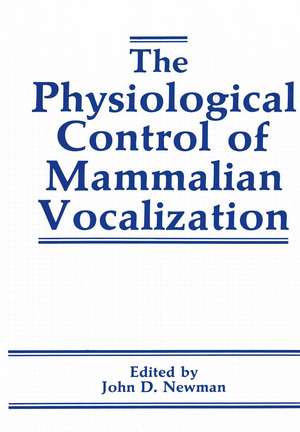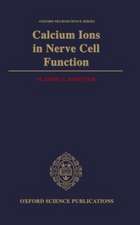The Physiological Control of Mammalian Vocalization
Editat de J.D. Newmanen Limba Engleză Paperback – 28 oct 2011
Preț: 651.34 lei
Preț vechi: 766.28 lei
-15% Nou
Puncte Express: 977
Preț estimativ în valută:
124.64€ • 133.28$ • 103.92£
124.64€ • 133.28$ • 103.92£
Carte tipărită la comandă
Livrare economică 17 aprilie-01 mai
Preluare comenzi: 021 569.72.76
Specificații
ISBN-13: 9781461283102
ISBN-10: 1461283108
Pagini: 456
Ilustrații: 438 p.
Dimensiuni: 170 x 244 x 24 mm
Greutate: 0.72 kg
Ediția:Softcover reprint of the original 1st ed. 1988
Editura: Springer Us
Colecția Springer
Locul publicării:New York, NY, United States
ISBN-10: 1461283108
Pagini: 456
Ilustrații: 438 p.
Dimensiuni: 170 x 244 x 24 mm
Greutate: 0.72 kg
Ediția:Softcover reprint of the original 1st ed. 1988
Editura: Springer Us
Colecția Springer
Locul publicării:New York, NY, United States
Public țintă
ResearchCuprins
and Brainstem Mechanisms.- Investigating the Physiological Control of Mammalian Vocalizations.- On the Motor Coordination of Monkey Calls.- Functional Neural Pathways for Vocalization in the Domestic Cat.- Studies on the Relation of the Midbrain Periaqueductal Gray, the Larynx, and Vocalization in Awake Monkeys.- Neural Control of Vocalization in Bats at Peripheral to Midbrain Levels.- Auditory-vocal Integration in the Midbrain of the Mustached Bat: Periaqueductal Gray and Reticular Formation.- The Coordination of Intrinsic Laryngeal Muscle Activation During Phonatory and Non-phonatory Tasks.- Forebrain Mechanisms.- The Feline Isolation Call.- Amygdaloid Electrical Activity in Response to Conspecific Calls in Squirrel Monkey (S. sciureus): Influence of Environmental Setting, Cortical Inputs, and Recording Site.- The Central Control of Biosonar Signal Production in Bats Demonstrated by Microstimulation of Anterior Cingulate Cortex in the Echolocating Bat, Pteronotus parnelli parnelli.- Evolution of Audiovocal Communication as Reflected by the Therapsidmammalian Transition and the Limbic Thalamocingulate Division.- Structure and Connections of the Cingulate Vocalization Region in Rhesus Monkey.- Cingulate Gyrus and Supplementary Motor Correlates of Vocalization in Man.- Neural Correlates of Audio-Vocal Behavior Properties of Anterior Limbic Cortex and Related Areas.- Neurochemical Mechanisms and Biobehavioral Correlates.- Neural and Neurochemical Control of Separation Distress Call.- Ontogeny of Adrenergic and Opioid Effects on Separation Vocalizations in Rats.- Primate Models for the Management of Separation Anxiety.- Rat Pup Ultrasonic Isolation Calls and Benzodiazepine Receptor.- Drug Effects on Primate Alarm Vocalizations.- Endocrine and Neurochemical Sequelae of Primate Vocalizations.- Early Detection of the Infant at Risk Through Cry Analysis.- Influence of Infant Cry Structure on Heart Rate of the Listener.













